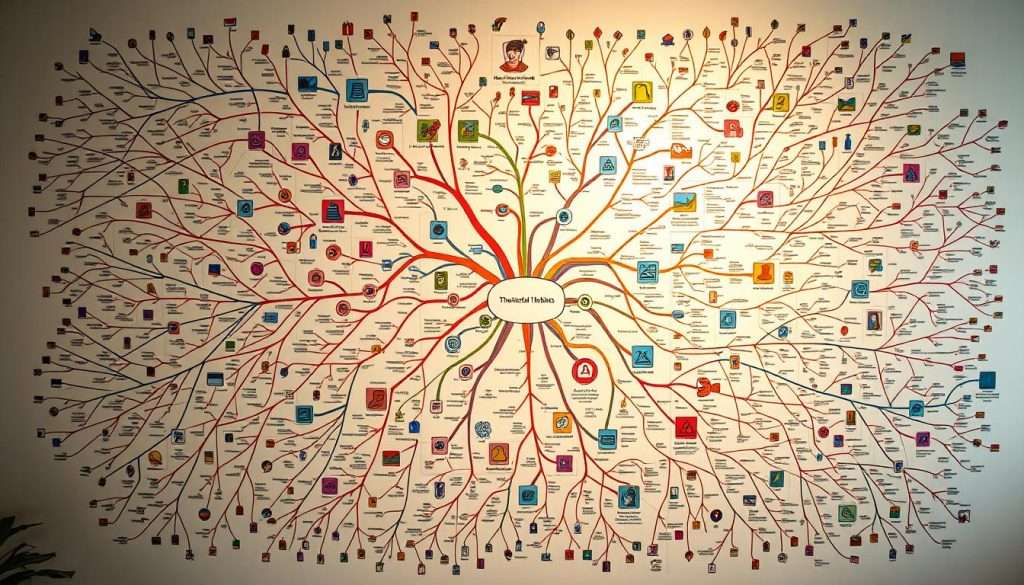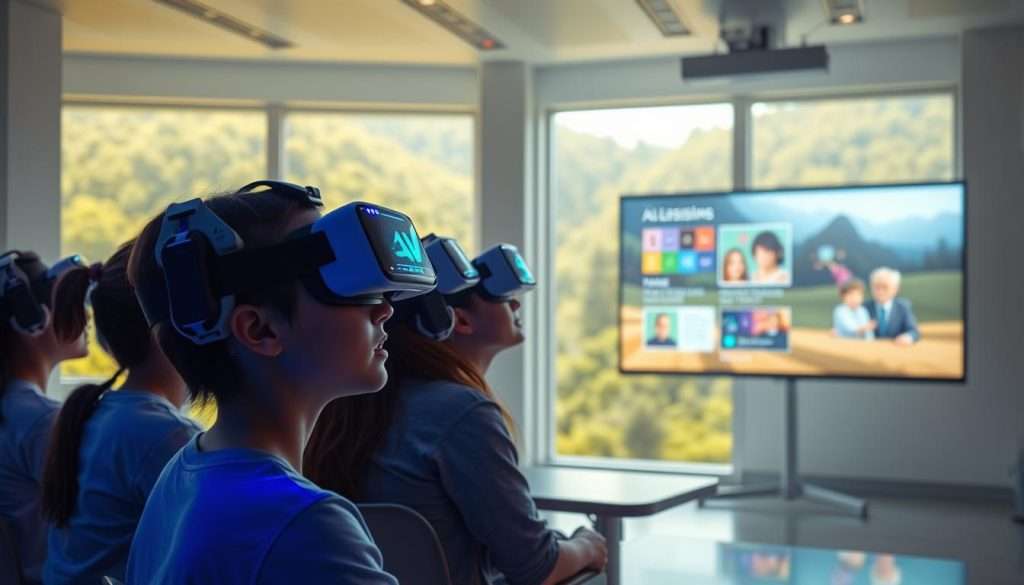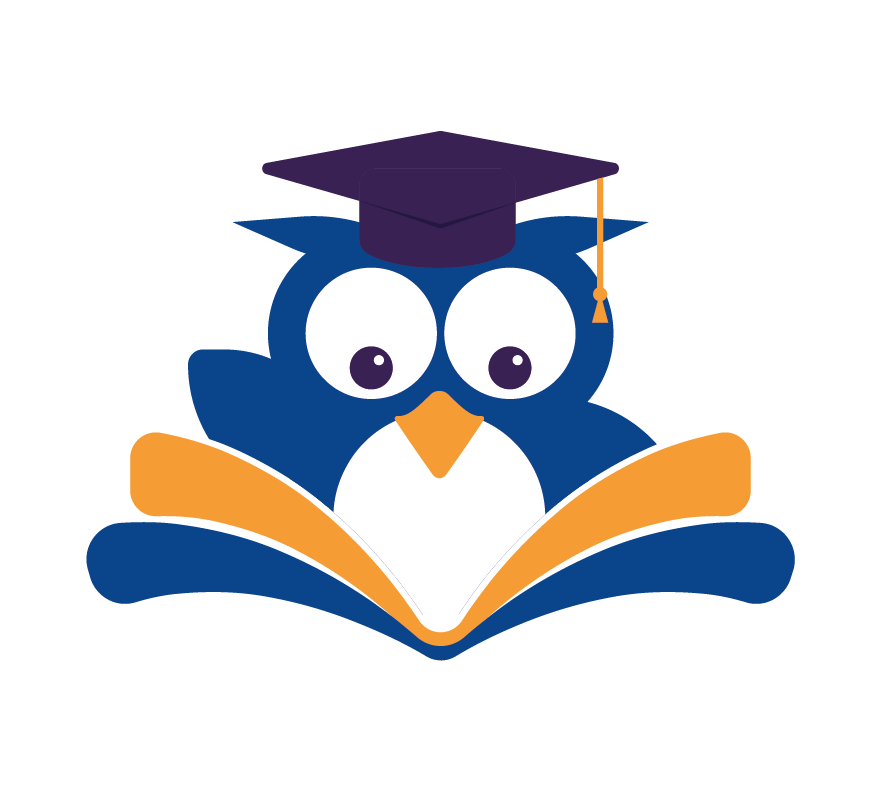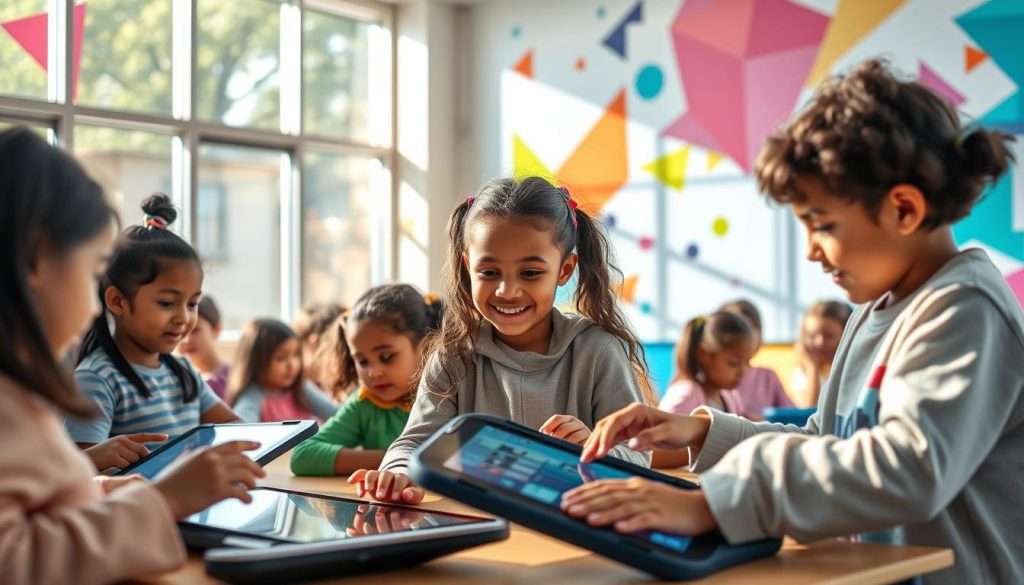We often think creativity is only for artists, writers, or musicians. But it’s inside all of us! It’s not just about thinking differently or coming up with new ideas. creativity fuels progress and innovation in our everyday lives.
By using innovative learning methods, we can reach our full potential. Learning becomes fun when we explore engaging study techniques. So, are you ready to unleash your creative side and find new ways to learn?
Key Takeaways
- Creativity is not limited to artistic pursuits; it’s a vital component of daily life.
- Innovative learning methods can make studying more engaging and effective.
- Embracing creativity can lead to new discoveries and personal growth.
- Engaging study techniques can stimulate the mind and foster a love for learning.
- Unleashing your creative potential can transform your learning experience.
The Science Behind Creative Learning
Creative learning is based on how our brains handle and adjust to new info. This ability to adapt is key to learning well. It lets us learn and use knowledge in new and creative ways.
How Your Brain Processes New Information
When we get new info, our brains go through many steps. The right side of the brain is linked to creativity and handling negative feelings. This balance is vital for artistic learning strategies and imaginative skill development.
Our brains can change and adapt, which is important for learning. This lets us update our brain’s pathways based on new experiences. By using this ability, we can develop interactive study habits that help us understand things better.
The Role of Dopamine in Engagement
Dopamine is known as the “feel-good” chemical in our brains. It’s key to staying interested in learning. When we do creative activities, dopamine helps us stay motivated and enjoy learning more.
Assessing Your Learning Style
Figuring out how you learn best can change how you study and learn new things. Just like Leonardo da Vinci carried a notebook, you can use your own way to capture ideas.
There are four main learning styles: visual, auditory, kinesthetic, and reading/writing. Each style shows a different way to learn and understand information.
Visual, Auditory, Kinesthetic, and Reading/Writing Preferences
Let’s look at each learning style to see which one fits you best.
- Visual Learners: You like using images, diagrams, and visual aids to get new concepts.
- Auditory Learners: You learn best by listening to lectures, discussions, and audio materials.
- Kinesthetic Learners: You do well with hands-on experiences, practical exercises, and real-world applications.
- Reading/Writing Learners: You prefer reading texts, writing notes, and creating written summaries to understand information.
Quick Self-Assessment Techniques
To find out your main learning style, try these quick tests:
- Think about your past learning experiences. What methods worked best for you?
- Try different learning methods. For example, watch a video (visual), listen to a podcast (auditory), or do a hands-on activity (kinesthetic).
- Notice how you naturally study or learn new things. Do you often take notes (reading/writing)?
Knowing your learning style helps you study better. You can tailor your study approach to reach your full learning potential. This way, you can enjoy unique educational experiences.
| Learning Style | Preferred Methods | Example Activities |
|---|---|---|
| Visual | Images, diagrams, charts | Watching educational videos, creating mind maps |
| Auditory | Lectures, discussions, audio materials | Listening to podcasts, attending seminars |
| Kinesthetic | Hands-on activities, practical exercises | Conducting experiments, role-playing |
| Reading/Writing | Reading texts, writing notes | Writing summaries, creating flashcards |
“Tell me and I forget, teach me and I may remember, involve me and I learn.” – Benjamin Franklin
By getting involved in learning and knowing your style, you can find creative ways to learn. This makes your education more effective and fun.
Creative Ways to Learn: Breaking the Conventional Mold
We’re going to explore new ways to learn that are fun and engaging. Traditional learning methods can be boring. It’s time to try something different.
The Limitations of Rote Memorization
Rote memorization helps you pass tests but doesn’t help you understand or remember things well. It’s a method that doesn’t spark curiosity or creativity. It doesn’t teach you to think critically, which is important in real life.
Embracing Curiosity-Driven Learning
Curiosity drives creativity. When you’re curious, you ask questions and explore new ideas. This makes learning more fun and effective.
Following Your Questions
Following your curiosity is a simple way to learn. When something interests you, dive into it! Research, ask experts, or try it out yourself. This makes learning more enjoyable and meaningful.
Creating Personal Learning Projects
Creating personal projects is another great strategy. Applying what you learn to real-life situations helps you understand and remember better. For example, if you’re learning a new language, write a story or talk to a native speaker.
| Traditional Learning | Curiosity-Driven Learning |
|---|---|
| Rote memorization | Active exploration |
| Passive reception of information | Engaging with the material through questions and projects |
| Limited retention and application | Better retention and practical application |
Ken Robinson once said, “If you’re not prepared to be wrong, you’ll never come up with anything original.”
“The function of creativity is not to create something from nothing, but to bring to fruition an existing idea or product that has not been realized.”
By embracing curiosity-driven learning, you’re not just memorizing facts. You’re building skills that will help you throughout your life. So, let’s get curious and start learning in a fun and effective way!
The Mind Mapping Revolution
Mind maps are more than just a way to organize. They open doors to unique learning experiences that boost creativity. By visually mapping out information, you create a network of knowledge. This network is easy to navigate and remember.
Creating Visual Knowledge Networks
Mind maps use images, colors, and words to show information. This method taps into the brain’s ability to process visuals better than text. It makes learning and remembering easier, turning it into an interactive study habit.

To make a mind map, begin with a central idea or topic. Then, add related subtopics, using colors and images to tell them apart. Here’s a simple guide:
- Start with a central idea or concept.
- Add main branches for key subtopics.
- Use keywords, images, and colors to enhance memory.
- Experiment with different layouts until you find one that works for you.
This creative way to learn helps organize and connect different pieces of knowledge. It makes your learning experience richer.
Storytelling as a Learning Tool
Imagine remembering even the toughest concepts easily. That’s what storytelling in learning does. It turns dry facts into fun stories, making learning a breeze.
Transforming Facts into Narratives
Turning facts into stories is a smart way to learn. It uses your brain’s love for stories. This method makes learning fun and helps you remember better by connecting emotionally to the material.
To start, pick the main points you want to learn. Then, think of how to turn these into a story. Add vivid images, characters, and twists to keep it interesting.
The Story Structure Method helps you create a story with a clear start, middle, and end. This keeps you interested and helps you remember better.
- Start with a hook to grab your attention.
- Build the narrative by adding details and complexity.
- Conclude with a summary or a reflection on what you’ve learned.
Using this method, you’re not just memorizing. You’re building your imaginative skill development. This makes recalling information easier and more fun.
As you get better at using storytelling for learning, you’ll find it easier to remember things. Learning will become more enjoyable and creative.
Gamification: Learning Through Play
By adding game design to our study habits, we can make learning more fun. Gamification uses game elements in learning to make it enjoyable. It turns studying into a fun, competitive activity.
Designing Personal Learning Games
To start, design a game that’s both fun and educational. Set clear goals, create challenges, and establish rules. You can make your game fit your learning style, whether you’re visual, auditory, or kinesthetic.
Card Games for Concept Mastery
Card games are a great way to gamify learning. Make flashcards with key terms on one side and their definitions on the other. Use these cards for memory games or quizzes. This method is excellent for mastering new concepts and vocabulary.
Creating Quiz Competitions
Another fun way to learn is through quiz competitions. Design quizzes on your study topics and challenge yourself or others. This competitive element can make learning more exciting and motivate you to study harder.
As the famous educator,
“The greatest sign of success for a teacher is to be able to say, ‘The children are now working as if I did not exist.'”
While this quote by Maria Montessori highlights the importance of independent learning, gamification takes it a step further. It makes the process enjoyable and interactive.
In conclusion, gamification offers a unique and innovative approach to learning. By designing personal learning games, such as card games and quiz competitions, you can make studying more engaging and fun. So, why not give it a try and see the difference it can make in your learning journey?
Arts-Integrated Learning Approaches
Let’s dive into how arts-integrated learning can change your study habits! It mixes art with school subjects to make learning fun and effective. Studies show it boosts memory, creativity, and grades.
Music and Rhythm as Memory Aids
Music is great for remembering things. It makes learning stick in your mind. Use songs to remember dates, formulas, or words.
Creating Educational Songs and Jingles
Making your own songs and jingles is a fun way to learn. Here’s how to start:
- Identify the information you want to remember
- Choose a familiar tune or melody
- Adapt the lyrics to fit the information you’re trying to memorize
- Practice singing or reciting the song regularly
Here’s an example of using music to remember key concepts:
| Concept | Musical Mnemonic |
|---|---|
| Order of Operations | “Please Excuse My Dear Aunt Sally” (Parentheses, Exponents, Multiplication and Division, and Addition and Subtraction) |
| Planets in Our Solar System | “My Very Excellent Mother Just Served Us Nachos” (Mercury, Venus, Earth, Mars, Jupiter, Saturn, Uranus, Neptune) |
Adding arts to your study routine makes learning fun and effective. So, why not try it and see the difference?
Technology-Enhanced Creative Learning
We’re diving into the world of tech-enhanced learning, where new methods are changing how we learn. Technology in schools makes studying fun and interactive. It’s a big change.
Augmented and virtual reality (AR/VR) are big players in this shift. They create immersive environments that let us explore real-world scenarios. This makes hard topics easier to grasp.
Augmented and Virtual Reality Learning Experiences
AR/VR are changing education by offering unique educational experiences. Students can now visit historical sites or explore planets without leaving class. It’s a new way to learn.

AR/VR tools are getting easier to use for learning on your own. Devices are cheaper and simpler, so you can learn outside of school too.
Using AR/VR for learning has many benefits:
- Learning experiences that fit your needs
- More fun and motivation
- Better memory of complex info
As tech keeps improving, we’ll see even more cool uses of AR/VR in schools. It will make learning even better.
Overcoming Creative Blocks in Learning
When learning feels like a chore, it’s time to break through creative blocks. We’ve all hit a wall – staring blankly, feeling stuck, and unsure how to proceed. The good news is that there are ways to overcome these hurdles and keep learning with excitement.
Recognizing and Addressing Learning Fatigue
Learning fatigue shows up in many ways, like a lack of motivation or trouble focusing. Spotting these signs is key to solving the problem. Once you acknowledge it, you can start finding ways to get back on track.
Warning Signs and Immediate Interventions
Common signs of learning fatigue include persistent frustration, difficulty concentrating, and a general feeling of burnout. To tackle it, take a break and do something creative, like drawing or listening to music. You might also want to change your environment or break down your study material into smaller, manageable chunks.
By being proactive and spotting learning fatigue early, you can beat creative blocks. Using engaging study techniques and creative learning methods keeps you motivated and on track to reach your goals.
Measuring Success with Creative Learning Methods
Exploring new ways to learn is exciting. But, how do we know if these methods work? Traditional tests don’t always show the full picture of unique educational experiences. So, what’s the best way to measure the success of innovative learning methods?
Beyond Standardized Testing: Alternative Assessments
For years, tests have been key in education. But, they’re not the only way to see how well someone learns. Other ways, like project-based checks, peer reviews, and self-evaluations, give a fuller view of a student’s growth.
One great way to assess learning is through personal knowledge portfolios. These are collections of a learner’s work and thoughts over time. They show not just what they know, but also their skills and personal growth.
Using personal knowledge portfolios helps us understand learners better. It lets them reflect on their learning and set goals for the future. This way, learners become more involved in their own assessment.
Conclusion: Crafting Your Personalized Creative Learning Journey
Embracing creativity is crucial for a fun and effective learning experience. By using creative ways to learn like mind mapping and storytelling, you can make learning exciting. This approach helps you break free from old learning methods.
Engaging study techniques such as arts-integrated learning make a big difference. They help you remember information better and stay motivated. Using these artistic learning strategies turns studying into an adventure.
Now, it’s your turn to create your own learning path. Try out different techniques and don’t be scared to explore new ones! Remember, the best learning approach is one that fits your needs and interests.
By being creative and trying new learning methods, you’ll reach your educational goals. You’ll also unlock your full potential.

